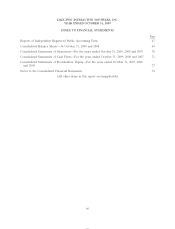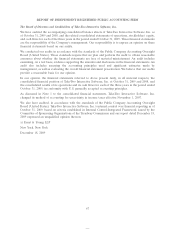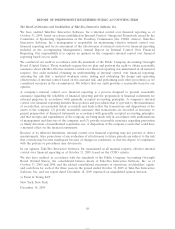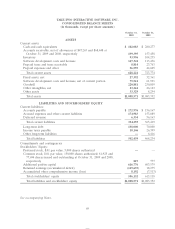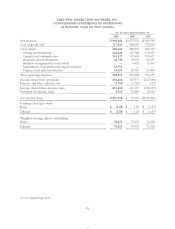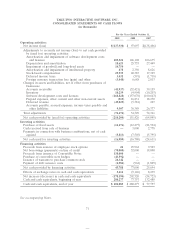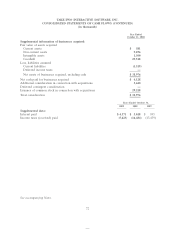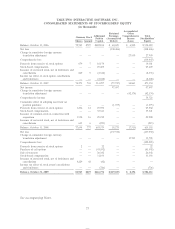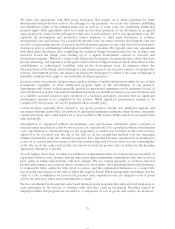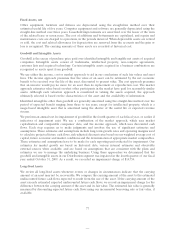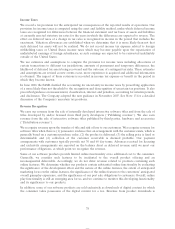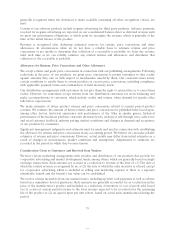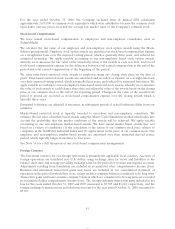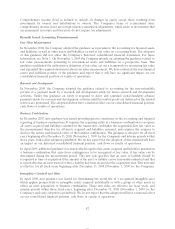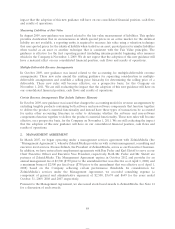2K Sports 2009 Annual Report Download - page 80
Download and view the complete annual report
Please find page 80 of the 2009 2K Sports annual report below. You can navigate through the pages in the report by either clicking on the pages listed below, or by using the keyword search tool below to find specific information within the annual report.maturities. We consider all highly liquid instruments purchased with original maturities of three months or
less to be cash equivalents. At October 31, 2009 and 2008 we had $9,235 and $3,199, respectively, of cash
on deposit reported as a component of prepaid expenses and other in the accompanying consolidated
balance sheet because its use was restricted.
We transact business in various foreign currencies and have significant sales and purchase transactions
denominated in foreign currencies. From time to time, we use forward exchange contracts to mitigate
foreign currency risk associated with foreign currency assets and liabilities, primarily cash balances and
certain inter-company receivables and payables. These transactions primarily relate to non-functional
currency denominated inter-company funding loans, non-functional currency denominated accounts
receivable and non-functional currency denominated accounts payable. We do not enter into derivative
financial instruments for trading purposes. We do not designate foreign currency forward contracts as
hedging instruments and accordingly, we mark to market our foreign currency forward contracts each
period and any gains and losses are recognized in net income (loss). At October 31, 2009, we had forward
contracts outstanding to purchase $30,400 of foreign currency in exchange for U.S. dollars with a 30 day
maturity to November 30, 2009. We recorded a $73 foreign currency transaction loss related to these
contracts in interest and other expense, net at October 31, 2009. At October 31, 2008, we had no
outstanding foreign currency forward contracts.
Concentration of Credit Risk and Accounts Receivable
We maintain cash balances at several major financial institutions. While we attempt to limit credit
exposure with any single institution, balances often exceed insurable amounts.
If the financial condition and operations of our customers deteriorate, our risk of collection could increase
substantially. A majority of our trade receivables are derived from sales to major retailers and distributors.
Our five largest customers accounted for 48.0%, 40.2% and 51.1% of net revenue in each of the three
years ended October 31, 2009, 2008 and 2007, respectively. As of October 31, 2009 and 2008, the five
largest customers accounted for 56.5% and 39.0% of our gross accounts receivable, respectively.
Customers that individually accounted for more than 10% of our gross accounts receivable balance
comprised 47.9% and 11.8% of such balances at October 31, 2009 and 2008, respectively. Except for the
largest customers noted above, all receivable balances from the remaining individual customers are less
than 10% of our net receivable balance. We believe that the receivable balances from these largest
customers do not represent a significant credit risk based on past collection experience.
Inventory
Inventory is stated at the lower of average cost or market. Estimated product returns are included in the
inventory balance at their cost. We regularly review inventory quantities on-hand and in the retail channels
and record an inventory provision for excess or obsolete inventory based on the future expected demand
for our products. Significant changes in demand for our products would impact management’s estimates in
establishing our inventory provision.
Software Development Costs and Licenses
Capitalized software development costs include direct costs incurred for internally developed titles and
payments made to third party software developers under development agreements.
We capitalize internal software development costs (including stock-based compensation, specifically
identifiable employee payroll expense and incentive compensation costs related to the completion and
release of titles), third party production and other content costs, subsequent to establishing technological
feasibility of a software title. Technological feasibility of a product includes the completion of both
technical design and game design documentation.
75



